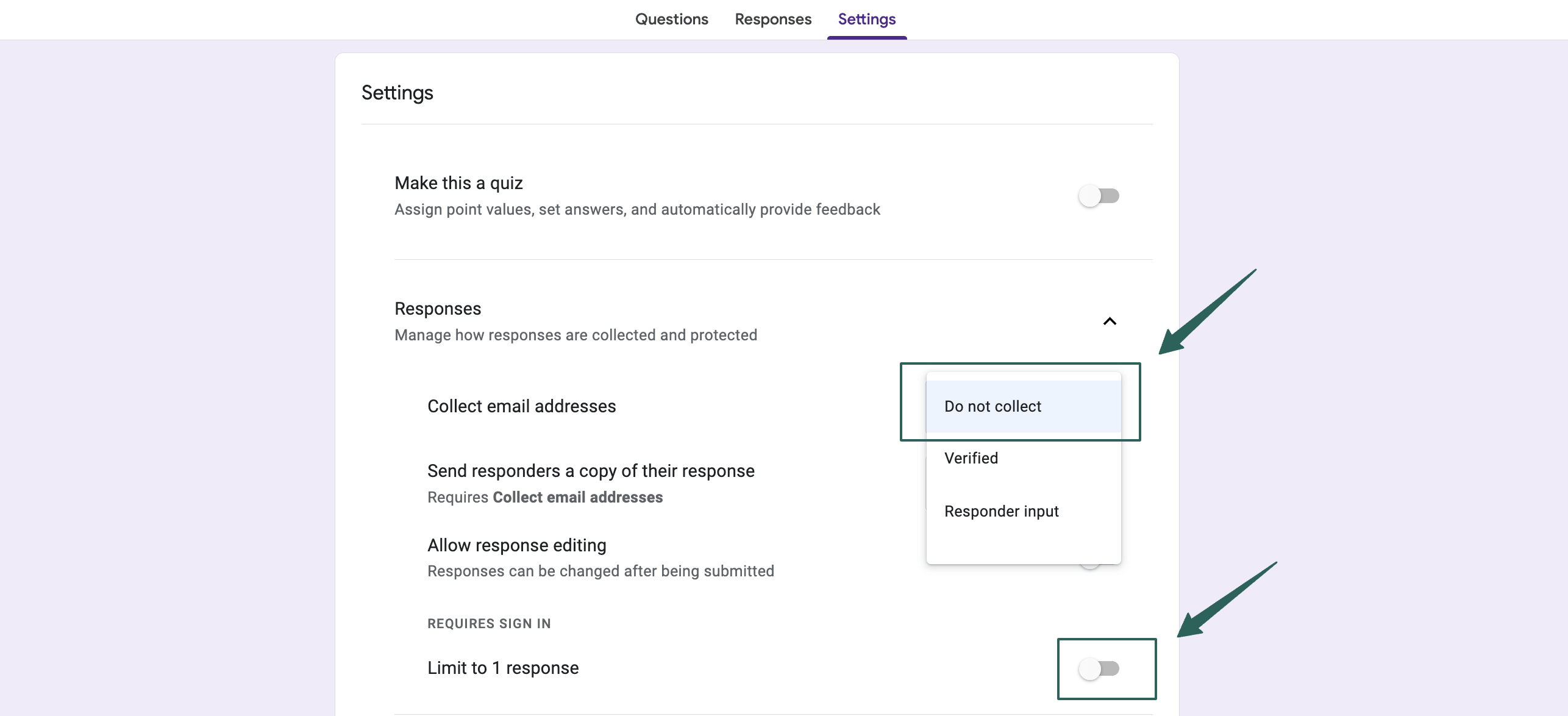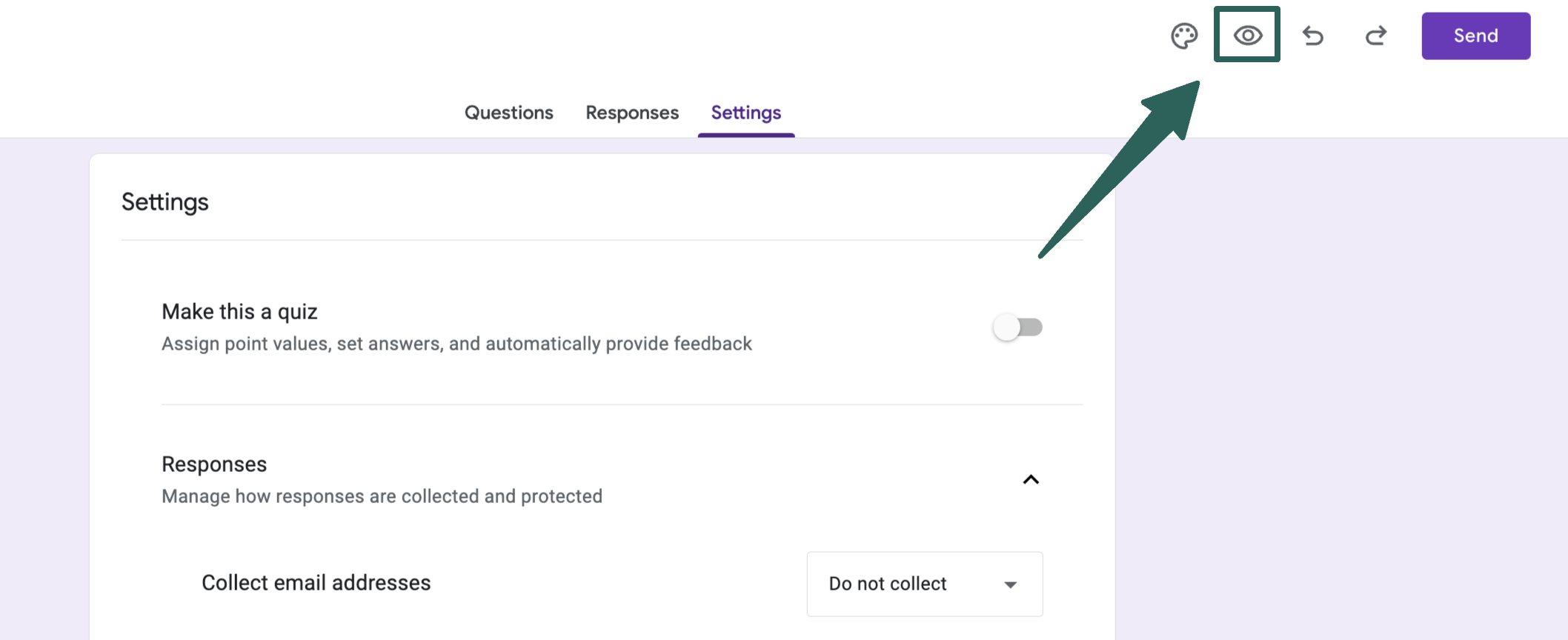Survey & Feedback
How to Make Google Forms Anonymous: A Comprehensive Guide
Article written by Kate Williams
Content Marketer at SurveySparrow
8 min read
19 September 2025

Have you ever conducted a survey and wished the responses were more…honest? Anonymity is a crucial factor in collecting genuine feedback. While Google Forms doesn’t offer a built-in mode, this blog will tell you how to make them anonymous.
But before that, you need to understand something.
What is an Anonymous Survey?
An anonymous survey, by definition, is one that does not ask for the Personal Identifiable Information (PII )of the respondent. This includes name, email address, age, or other unique identifiers.
For instance, there might be situations when a respondent wants to give candid feedback but hesitates due to privacy concerns. Take the case of freshers who joined a company recently. Though they wish to report an incident directly, ensuring confidentiality lets them share their thoughts freely without fearing judgment.
People do not often want their responses and personal information to be linked. So, anonymous surveys act as a secret ballot for feedback and opinions.
Did you get the gist?
Now, let’s learn how to create one.
How to Make Google Forms Anonymous?
You can make Google Forms anonymous simply by not collecting email addresses from the respondents. Choose “Do Not Collect” in the drop-down list for “Collect Email Address” in the settings.
Also, remember to Disable “Limit to 1 Response.” (If you don’t, the respondent will have to sign in to answer the survey)

If you want a detailed guide, here is one.
A Four-Step Guide
Step 1: Create a Google Forms Account
Let’s start with the basics. We can’t do anything with the platform if you do not have a Google account.
But that won’t be a problem, I assume. Most people have one, right? If you don’t, make sure you create one.
Step 2: Create a New Form
- Click on the (+) blank form or choose one from already existing ones

If it is a new one-
Once you click on it, you will be presented with an untitled form.
- Add a Title and Description.
- Add questions by choosing from the list of question types.
Read More: How to Create a Survey in Google Forms: A Step-By-Step Guide
Once you have a form, it’s time to work on the back end.
Step 3: Disable Email Collection

In the Settings, right under Responses, you’ll find the option “Collect email addresses.”
- Ensure the “Do Not Collect” option from the drop-down menu is selected.
Step 3: Avoid Limiting Responses
- Toggle off the Limit to 1 response.
(Disabling it lets respondents submit multiple responses. Though this is not strictly necessary for anonymity, it makes tracking individual responses a hassle!)
That’s about it. We have an anonymous form. But before making it live, make sure you test and then share.
Step 4: Test and Share
Before sharing your form with the world, give it a test run!

- Click on the “eye” icon in the top right corner to take a sneak peek at your form. Once you’re there, submit a test response to ensure that our invisibility cloak is working its magic.
- If you’re satisfied, share the form using the provided link via email or embed it on your desired platform.
Wasn’t that simple?
While Google Forms gives you a straightforward process, some users might want more advanced features and a streamlined form-building process. SurveySparrow can be a compelling alternative!
How?
Apart from built-in anonymity, you can create conversational forms that reap 40% more responses. It’s like a double lock! Confidentiality and engagement to keep your audiences hooked.
Here is a sample survey you can fill out. Feel free to use or customize it to make it your own if you like it.
That’s not it! The intuitive interface and drag-and-drop builder make form building as easy as pie.
If you wish to create engaging surveys from scratch or access 1000+ pre-designed templates, sign up today!
14-day free trial • Cancel Anytime • No Credit Card Required • No Strings Attached
Importance of Anonymous Surveys
Now that we know how to create an anonymous survey, it is important to know why anonymity is so important.
- Honest Answers: When people feel like their answers won’t come back to bite them, they’re more likely to give it to you straight. An anonymous survey creates a safe space for folks to be real and share their thoughts.
- More People Jump In: Knowing their name won’t be tied to their responses makes them more comfortable joining in. It’s like opening the door wider and inviting more voices to the conversation.
- Keeping Bias in Check: You’re removing the pressure to give the “right” answer. This means fewer people need to please or conform, giving you a clearer picture of what’s happening.
- Building Trust: Respecting people’s privacy is a big trust-builder. They’re more likely to open up and share when they know you’ve got their back and won’t expose their thoughts.
- Staying Legal: Sometimes, you must keep things anonymous to stay on the right side of the law. It’s not just about being polite; it’s about following the rules and keeping everyone’s data safe and sound.
Read More: How to Use Anonymous Surveys to Collect Sensitive Data
But is there a flip side to anonymity?
Cons of Anonymous Surveys
Yes, there is!
- Missing Context: Sometimes, understanding where a response comes from is as important as the response itself. You lose that context with anonymity, making it harder to interpret the feedback accurately.
- Limited Follow-Up: It’s tough to follow up on responses or clarify any unclear answers without knowing who said what. You’re kind of left in the dark, unable to dig deeper into people’s thoughts.
- Potential Abuse: Anonymity can sometimes be misused. People can use it as a shield to say hurtful or inappropriate things. It’s like giving someone a mask. They might feel emboldened to act out in ways they wouldn’t otherwise.
- Less Personal Connection: When you strip away identities, you also strip away the personal connection between you and your respondents. It’s like talking to a faceless crowd rather than having a one-on-one conversation.
Wrap Up!
Knowing how to make Google Forms anonymous is essential for gathering candid feedback.
Remember, anonymity isn’t just about protecting identities. Instead, it’s all about honesty, increasing participation, and building trust. Weighing the pros and cons and choosing the best approach that suits your needs is essential.
Bonus Tip!
Why don’t you consider adding a friendly note to your form? Acknowledge the anonymity of the survey and assure participants that their identities will be kept confidential. A straightforward message like, “Your responses are anonymous, and your identity will remain confidential,” adds that extra layer of professionalism while keeping things casual and reassuring.
Now, before you go, why don’t you give SurveySparow a try? A 14-day free trial will help you understand better.
14-day free trial • Cancel Anytime • No Credit Card Required • No Strings Attached

Create engaging surveys that people actually complete. Try SurveySparrow now!
Kate Williams
Related Articles

Survey & Feedback
Ever thought of Amping Up Surveys through Video? Well, We have and We can!
4 MINUTES
12 December 2019

Survey & Feedback
Quantitative Data Collection: A Quick Guide for Beginners
13 MINUTES
8 May 2023

Survey & Feedback
Behaviorally Anchored Rating Scale: All You Need to Know
7 MINUTES
26 December 2022

Survey & Feedback
Defining Survey Goals and Objectives: A Quick Guide
9 MINUTES
31 May 2021
